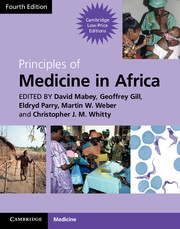Book contents
- Frontmatter
- Contents
- Contributors
- Foreword
- Section 1 Health and disease
- Section 2 Mother and child health
- Section 3 Infection: general principles
- Section 4 Major common infections
- Section 5 Bacterial infections
- Section 6 Viral Infections
- 34 Viral haemorrhagic fevers: yellow fever, Lassa fever, Rift Valley fever, Ebola/Marburg fever and Crimean–Congo fever
- 35 Dengue
- 36 Rabies
- 37 Influenza
- 38 Poliomyelitis
- 39 Varicella (chickenpox), herpes zoster and monkeypox
- 40 Rubella
- 41 Mumps
- Section 7 Protozoal infections
- Section 8 Helminth infections
- Section 9 Fungal infections
- Section 10 Non-communicable diseases
- Section 11 Diseases of body systems
- Section 12 Cancer and Palliative Care
- Section 13 Venoms and Poisons
- Index
- References
37 - Influenza
from Section 6 - Viral Infections
Published online by Cambridge University Press: 05 March 2013
- Frontmatter
- Contents
- Contributors
- Foreword
- Section 1 Health and disease
- Section 2 Mother and child health
- Section 3 Infection: general principles
- Section 4 Major common infections
- Section 5 Bacterial infections
- Section 6 Viral Infections
- 34 Viral haemorrhagic fevers: yellow fever, Lassa fever, Rift Valley fever, Ebola/Marburg fever and Crimean–Congo fever
- 35 Dengue
- 36 Rabies
- 37 Influenza
- 38 Poliomyelitis
- 39 Varicella (chickenpox), herpes zoster and monkeypox
- 40 Rubella
- 41 Mumps
- Section 7 Protozoal infections
- Section 8 Helminth infections
- Section 9 Fungal infections
- Section 10 Non-communicable diseases
- Section 11 Diseases of body systems
- Section 12 Cancer and Palliative Care
- Section 13 Venoms and Poisons
- Index
- References
Summary
The problem in Africa
There is a background rate of influenza in all parts of the world including Africa, where influenza may cause around 5 per cent of severe paediatric pneumonia (Berkley et al., 2010). It is indistinguishable from other viral causes of upper respiratory tract infection unless you have access to sophisticated diagnostic facilities. Under ordinary circumstances those who are at risk of dying from influenza are the very young and the very old; there is some evidence the risk is higher in Africa than elsewhere in these groups (Cohen et al., 2010). Outside epidemics influenza is seldom reliably diagnosed and therefore specific treatment for influenza is unlikely to be instituted.
The virus, clinical features and treatment.
Influenza is a single-stranded RNA virus transmitted by droplets in the air or on hands or fomites. Influenza normally causes fever, cough and general malaise. Influenza in Africa is generally a clinical diagnosis. Death can occur both by a primary process caused directly by influenza virus, including a primary viral pneumonia, or later by a secondary bacterial infection of the lungs including with staphylococcus. If you suspect influenza and the case is severe, treating with broad spectrum antibiotics clearly has a role to reduce the risk of this secondary complication. Broad spectrum antibiotics such as doxycycline or co-amoxiclav which would cover pneumococcus and staphylococcus should be used. Where it is available, patients may need respiratory support.
- Type
- Chapter
- Information
- Principles of Medicine in Africa , pp. 388 - 389Publisher: Cambridge University PressPrint publication year: 2013

